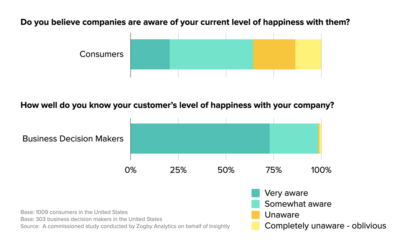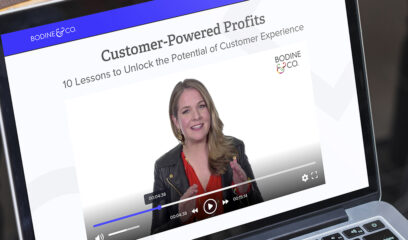JetBlue built its brand on being a different kind of airline. At a time when other US-based airlines were cutting leg room, eliminating meals, and charging for bags, JetBlue gave flyers room to stretch, provided free yummy snacks, and resisted financial pressure to nickel and dime its customers with fees.
The airline seemed to know it had a good thing going. Its marketing team flaunted JetBlue’s differentiated customer experience with cheeky ad lines like “Someone has to stand up for tall people.” and “Trays. Knees. Never the two shall meet.” They launched a series of videos showcasing the reactions of unsuspecting New Yorkers as taxi drivers tried to charge them for putting their luggage in the trunk, and hot dog vendors sold them tiny plastic cups of Coke.
But that’s not all. One of JetBlue’s most memorable ads simply read, “Not a tagline. A promise.” Unfortunately, it wasn’t a promise that JetBlue could keep.
In November 2014, JetBlue announced that it would be adding baggage fees and reducing leg room – and on June 30, 2015, the airline kept that promise to investors. I’m not a financial analyst, but it seems as though investors were initially bullish about the potential revenue boost JetBlue’s broken customer promises would deliver; the stock price surged after the November 2014 announcement. But are customers sticking with JetBlue? The answer is questionable, as JetBlue’s stock price has fallen sharply from an all-time high of nearly $27 per share in September 2015 to roughly $17 at press time.
Every Chief Marketing Officer should take heed of this lesson. When you make a big promise – the kind on which the character of your brand is built – will your CEO and Board of Directors have your back? Not tomorrow, not next week, and not next year – but for the life of your brand. Or will they shift their alliances, forgetting that it’s indeed happy customers who create happy shareholders?
Marketers need to make their big promises thoughtfully and with a full understanding of the kind of experience the organization is prepared to deliver today and down the road. But marketers aren’t the only people who make promises to customers.
Your sales agents promise that your product or service will deliver certain benefits. Your website promises that a specific car or hotel room will be available. Your delivery drivers promise to be there between 1:00 and 3:00pm. Your customer service reps promise to call the customer with an answer. Your wait staff promises to be right back with that pinot noir. Your Facebook links promise to change readers’ lives in three simple steps.
Your organization makes thousands of small promises to customers every day. These promises flow naturally from your employees as they talk, email, or chat with your customers. And they’re designed into all of your digital touchpoints. Your employees and partners – both those on the front line and those who work behind the scenes – make these small promises with good intentions and the sincere belief that they (or someone else in the organization) will deliver on them.
On some level, these small promises don’t seem as important as the big ones. After all, they can’t destroy your brand or alienate a large number of customers in one fell swoop. But these small promises, when broken again and again over time, can kill your brand by death from a thousand cuts. To complicate matters, they get lost in the bigger picture of customer interactions and transactions, which makes them nearly invisible to Chief Customer Officers or others trying to manage and improve the customer experience.
Here are three simple steps to ensure that your organization can keep its promises, both big and small:
1. Set Realistic Expectations For Big Promises
No one in an organization should work in a vacuum. The people making big promises (marketers, mostly) should be in constant communication with development, operations, and any other part of the organization responsible for delivering on promises that form the backbone of the brand. Marketers should ask, “Are we prepared to deliver on this promise today? And if not, when?” United Airlines did this well in its September 2015 Hemispheres magazine: “Our fresh and healthy food menu is now available to United Club members and guests at all 22 United Club locations in our seven domestic airport hubs. By the end of 2015, the new menu will be available at all United Club locations in the U.S.”
2. Surface Organizational Awareness Of Small Promises
It’s often hard for us to see our own bad habits, but as luck would have it, we generally don’t have a hard time noticing others. Take advantage of this human quirk by asking employees to point out when they hear their colleagues making (or designing, or developing) small promises.
Make the discussion of small promises a topic of weekly team meetings. Ask for examples of promises kept – but perhaps most importantly, ask employees to reflect on promises that they didn’t keep and why.
Did they simply forget to respond to that customer email? Or are there more systemic problems that keep them from delivering on certain promises on a regular basis?
3. Keep Your Promises Through Greater Transparency
In the days before Uber, I would often call for a taxi that never arrived. This left me stressed and sweating to find another way to get to my favorite restaurant across town – or worse, to the airport. Uber’s certainly not perfect. But the transparency that it offers into its driver locations, projected fares, and surge pricing makes customers perceive that Uber is keeping its small promises.
As you look at your customer interactions, determine if there’s any underlying data – like inventory or timing – that you could present in real time to further help you set realistic expectations with customers.
***
This post originally appeared in Brand Quarterly magazine.




